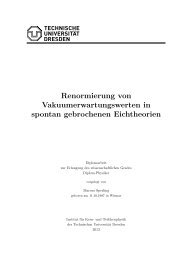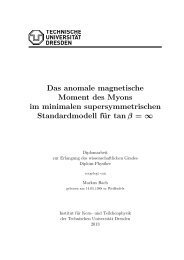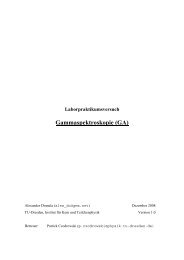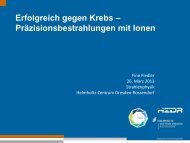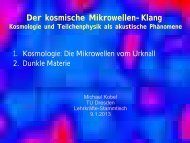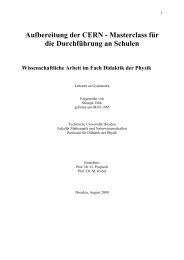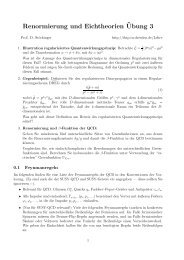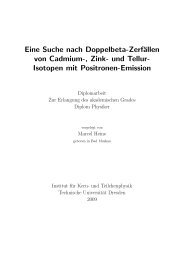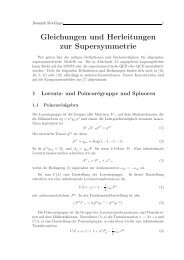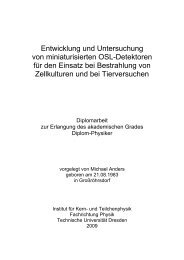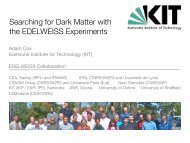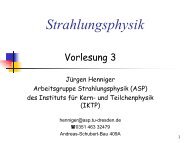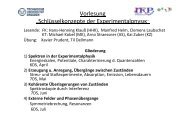a design study for a cobra upgrade to - Institut für Kern- und ...
a design study for a cobra upgrade to - Institut für Kern- und ...
a design study for a cobra upgrade to - Institut für Kern- und ...
You also want an ePaper? Increase the reach of your titles
YUMPU automatically turns print PDFs into web optimized ePapers that Google loves.
78 5 Scintilla<strong>to</strong>r <strong>upgrade</strong><br />
crystal positions 134 Cs events 116 Cd events<br />
N 48.32 % 78.31 %<br />
NN 17.01 % 15.26 %<br />
O 8.69 % 1.75 %<br />
R 25.98 % 4.68 %<br />
Table 5.9: Contribution of 2νββ decay of 116 Cd in<strong>to</strong> the first excited<br />
state and backgro<strong>und</strong> contribution of 134 Cs, <strong>for</strong> events with one involved<br />
CZT and two CsI detec<strong>to</strong>rs, categorised by positions of involved<br />
CsI crystals. Neighbouring crystals, which have a joint surface (N), next<br />
neighbouring crystals with a joint edge (NN), crystals at opposite sides<br />
of the Nest, having joint surfaces with the Nest (O) and crystals, being<br />
not in the <strong>for</strong>mer categorisation (R) are distinguished.<br />
ture process on 133 Cs. The measured 134 Cs contamination in the pollucite<br />
powder of aro<strong>und</strong> 12 mBq/kg corresponds <strong>to</strong> an exposure time<br />
of one year of neutron flux at see level. The saturated contamination<br />
after infinite exposure with a typical thermal neutron flux at see level<br />
was reported <strong>to</strong> be about 50 mBq/kg <strong>for</strong> pollucite powder and aro<strong>und</strong><br />
80 mBq <strong>for</strong> CsI powder. Accordingly, the 134 Cs contamination can only<br />
be reduced by limiting the exposure <strong>to</strong> thermal neutrons. This can be<br />
achieved by s<strong>to</strong>ring the crystals as soon as possible <strong>und</strong>ergro<strong>und</strong>, having<br />
short crystal production times and by s<strong>to</strong>ring and transporting the<br />
powder or crystal protected from thermal neutrons.<br />
238 U: With a reported contamination level of less than 0.75 ppt [55],<br />
there will be only aro<strong>und</strong> 10000 decays from the 238 U chain in the extended<br />
COBRA detec<strong>to</strong>r (assuming secular equilibrium). One million<br />
of the events from the nat. 238 U decay chain were simulated and they<br />
produce only 0.13 % coincident entries in single CZT and one or two<br />
CsI detec<strong>to</strong>rs (1CZT-1&2CsI). This lead <strong>to</strong> about 13 expected coincident<br />
events in the detec<strong>to</strong>r and <strong>to</strong> about 1 event in three years in the 3σ<br />
region aro<strong>und</strong> the 1294 keV line in the scintilla<strong>to</strong>r. The 238 U contamination<br />
in the scintilla<strong>to</strong>r are there<strong>for</strong>e negligible, compared <strong>to</strong> the other<br />
backgro<strong>und</strong> sources.<br />
232 TH: An even lower 232 Th contamination level of 0.38 ppt was reported<br />
by Lee et al. [55], leading <strong>to</strong> aro<strong>und</strong> 1600 decays per year in the<br />
scintillation detec<strong>to</strong>rs. Of these only 0.2 % produce coincident entries<br />
in one CZT and one or two CsI detec<strong>to</strong>rs. These are 3 coincident events<br />
per year, and about one in 5 years in a 3σ region.



